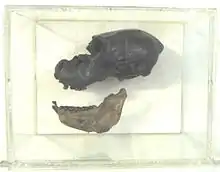Xenotrichini
Xenotrichini (the Antilles monkeys) is a tribe of extinct primates, which lived on the Greater Antilles as recently as the 16th century.
| Xenotrichini | |
|---|---|
 | |
| Paralouatta marianae skull | |
| Scientific classification | |
| Kingdom: | Animalia |
| Phylum: | Chordata |
| Class: | Mammalia |
| Order: | Primates |
| Suborder: | Haplorhini |
| Infraorder: | Simiiformes |
| Family: | Pitheciidae |
| Subfamily: | Callicebinae |
| Tribe: | †Xenotrichini MacPhee & Horovitz, 2004 |
| Genera | |
These Caribbean islands no longer contain endemic primates, although the most recently discovered species, the Hispaniola monkey, was reported to have lived on Hispaniola until the settlement by the Europeans. The relationship of these species is supported by details in the formation of the skull and the lower jaw, such as a reduction in the number of teeth.
The exact timing and causes of extinction are not well-known and their relationship and placement in the parvorder of the New World monkeys is unsure. Originally they were thought to be closely related to the night monkeys, but more recent research as placed them in Callicebinae subfamily, containing the titi monkeys.[1]
A 2018 DNA study of the Jamaican monkey suggested that it diverged from its closest relative Cheracebus around 11 Ma, during the Late Miocene, which is younger than the 18 Ma Paralouatta from Cuba, meaning that the Jamaican monkey has a separate origin from the rest of the Antillean monkeys, making the group polyphyletic.[2]
So far, five species of Xenotrichini are known:
- Jamaican monkey (Xenothrix mcgregori), from Jamaica.
- Cuban monkeys (Paralouatta varonai and P. marianae), the largest representatives of this group, from Cuba.
- Hispaniola monkey (Antillothrix bernensis), found on Hispaniola
- Insulacebus toussaintiana, found on Hispaniola
References
- MacPhee, R. D. E.; Horovitz, I. (14 May 2004). "New craniodental remains of the quaternary Jamaican monkey Xenothrix mcgregori (Xenotrichini, Callicebinae, Pitheciidae), with a reconsideration of the Aotus hypothesis". American Museum Novitates. 3434: 1–51. doi:10.1206/0003-0082(2004)434<0001:NCROTQ>2.0.CO;2.
- Woods, Roseina; Turvey, Samuel T.; Brace, Selina; MacPhee, Ross D. E.; Barnes, Ian (2018-12-11). "Ancient DNA of the extinct Jamaican monkey Xenothrix reveals extreme insular change within a morphologically conservative radiation". Proceedings of the National Academy of Sciences. 115 (50): 12769–12774. doi:10.1073/pnas.1808603115. ISSN 0027-8424. PMC 6294883. PMID 30420497.
